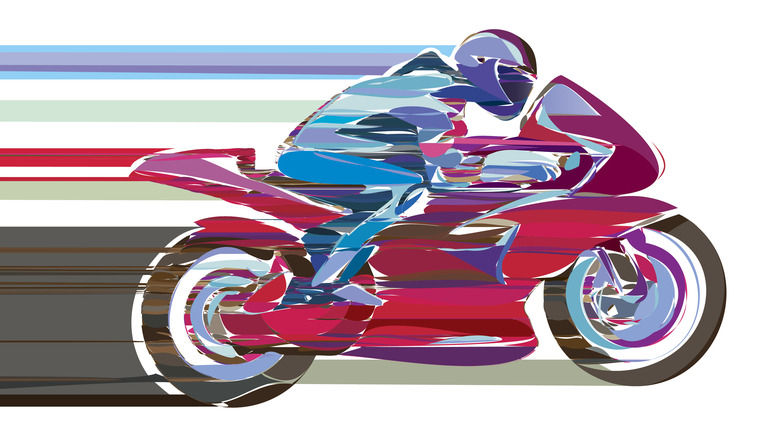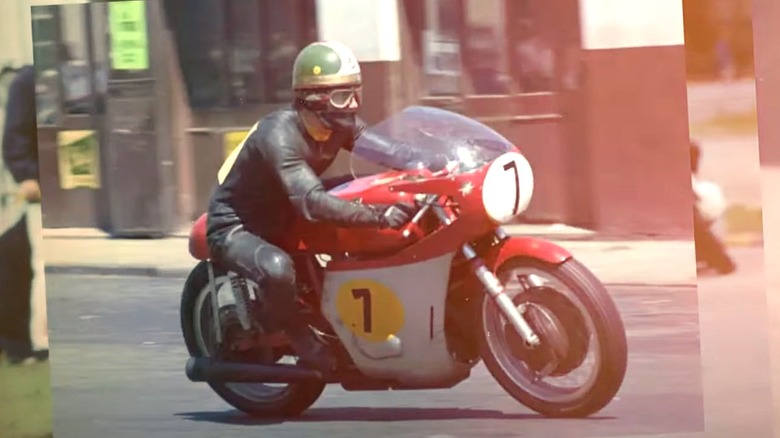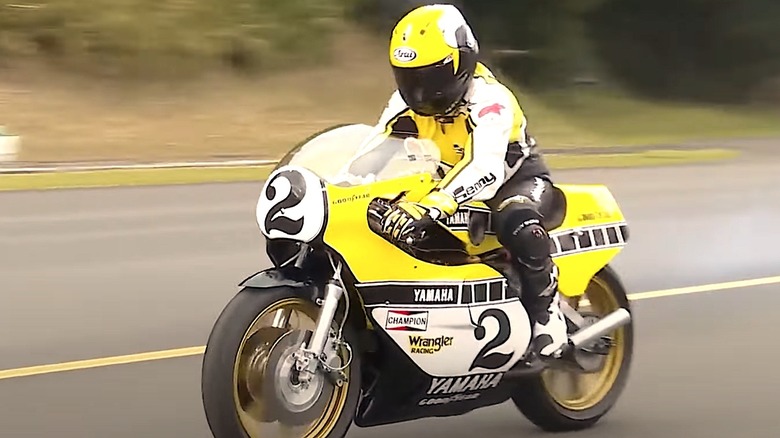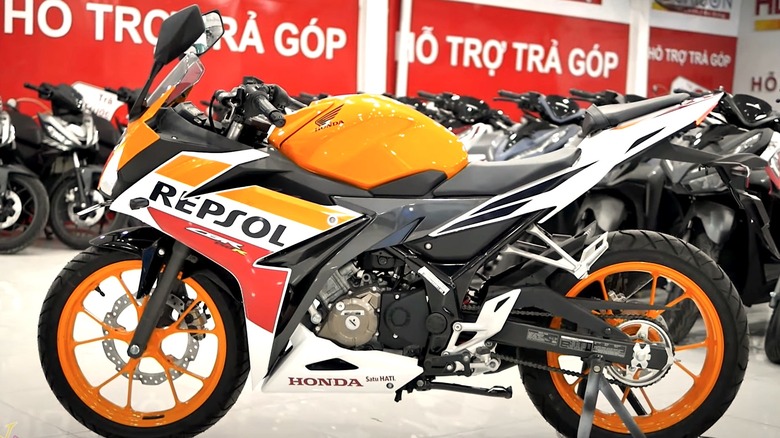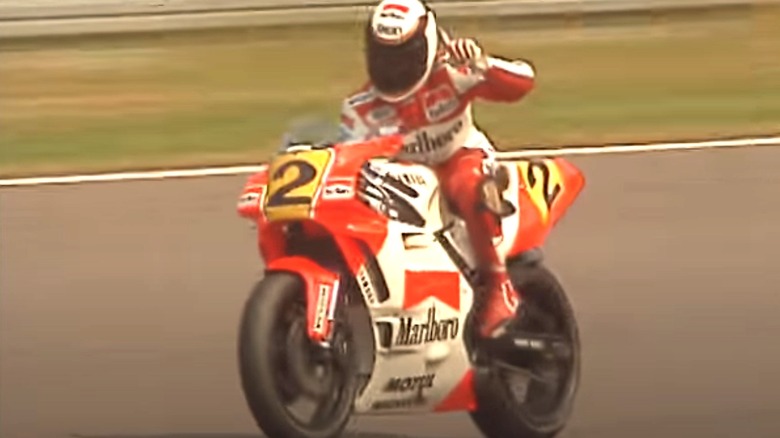5 Of The Most Iconic Motorcycle Liveries Of All Time
In the realm of motorcycle racing, there are countless factors that can set a racing team apart from the pack. Some of those differentiating factors are clear, with a bike's build, motor, parts, and rider ranking as the best ways for a team to gain an advantage on the track. Others are primarily aesthetic, however, and a team's livery is one of the most obvious ways they differentiate themselves on the track.
If you're unfamiliar with the term "livery," in racing, it essentially refers to a competitive vehicle's paint job and often includes a rider's style and color-coordinated jumpsuit. Given that motorcycles have less surface available to front a fancy paint job, teams tend to take the matter of their livery pretty seriously, as many want their bike to look as good on the track as they do in a Winner's Circle. These days, liveries also play a significant role in conveying a team's sponsorship.
Whatever the case, arguments could be made that a memorable livery can help elevate a team's status both on and off the track as much as wins and losses. These are five of the most memorable liveries in the history of motorcycle racing.
MV Augusta's red and silver is about as iconic as it gets in the motorcycle world
While branding is a big part of a bike's livery in today's MotoGP arena, that has not always been the case. During the early days of the motorcycle racing circuit, sponsorships didn't really exist the way they do today, and that means a bike's livery was more often inspired by the signature colors of the company that manufactured it.
If you're even casually familiar with MotoGP racing in the days before it was called that, you should know the circuit was pretty much dominated by MV Agusta and their souped-up stable of high-octane 500cc racing machines. For the bulk of MV Agusta's dominant run from the 1950s to mid-1970s, their bikes were adorned in the company's distinctive red and silver livery, and they could be seen blazing down the track with motorcycle racing legends like Giacomo Agostini, Mike Hailwood, John Surtees, Phil Read, and Gary Hocking in the saddle.
With names like those on the throttle, MV Agusta racked up numerous world champion titles during its heyday. It should go without saying that, in turn, their red and silver livery became one of the sport's most instantly identifiable. It remains just as singular today, even as the Italian motorcycle manufacturer has continued to develop some of the most beautiful two-wheeled speed machines on the market.
Kenny Roberts helped make Yamaha's black, white, and yellow the stuff of MotoGP legend
In motorcycle racing, few manufacturers have seen their bikes in the winner's circle quite as often as Yamaha. Few have consistently fielded a motorbike with such distinguished liveries either, and the legendary manufacturer has debuted their share on the MotoGP circuit. But when racing fans think about Yamaha's various MotoGP paint jobs, the black, white, and yellow livery of the Speed Block era is likely the first that comes to mind.
Yamaha sent their first Speed Block beauties to the racing circuit in the 1970s with the livery used primarily by their US riders. That list of riders boasts some of the biggest names in racing history, including "King" Kenny Roberts, Wayne Rainey, and Eddie Lawson. Roberts is arguably the most notable name there, and the legendary cyclist was atop a black, white, and yellow Yamaha when he became the first American rider to win a 500cc Grand Prix world championship in 1978. He rode that livery to world championship titles in 1979 and 1980, too.
Yamaha racers would continue to ride variations of the black, white, and yellow pattern into Winner's Circle through much of the 1980s, making it one of the company's most distinctive liveries to date. So much so that Yamaha celebrated its 50th anniversary in 2005 by having its riders (including Valentino Rossi) compete with throwback bikes adorned in the iconic colors.
Honda Repsol rode their iconic livery to multiple World Cup wins
Speaking of Valentino Rossi, Yamaha was not the only team he raced for that fronted a memorable livery. But the Honda Repsol team may have out-flashed even Yamaha with their stunning black, white, orange, and red setup. Just like many of the most iconic liveries in motorcycle racing, the Repsol team's style became synonymous with winning during its lengthy tenure.
Said tenure began in 1995, with Honda's NSR500s being the first bikes to hit MotoGP tracks in the Repsol style. As it happens, that year was the first that found Repsol teaming with Honda. The partnership has proven so fruitful for both sides that the companies continue it to this day. Of course, Repsol has long since moved on from Honda's MSR500s. But the livery was such a hit both parties opted to keep it mostly intact for the better part of their three-decade partnership. In fact, the livery got its first full-blown facelift just this year, with Honda Repsol finally debuting a revamped look ahead of the 2024 season.
Despite shaking up the look of its competition bikes, Honda Repsol will no doubt continue to chalk up wins on the Grand Prix circuit. Should that be the case, there's every reason to suspect the new livery will become as iconic as the last.
Yamaha and the Marlboro livery were regular winning circle fixtures in the 1990s
It's extremely rare to see a tobacco manufacturer's name splashed across the side of a race car or motorcycle anymore. But in the late 1980s and 1990s, it was common to see such sponsorship, with tobacco companies backing some of the most successful racing teams in motorsports. Fans of MotoGP are more aware of that than many other racing outlets, as bikes brandishing the logos for Marlboro or Lucky Strike cigarettes were a regular sight at the front of any pack.
Marlboro has been one of the most visible fixtures in motorcycle racing over the years, with logos turning up on MotoGP uniforms as early as the 1970s. By the '80s, they'd become a legitimate force in the MotoGP world, with their red and white livery adorning the motorcycles of none other than Team Yamaha. That livery supplanted Yamaha's beloved black, white, and yellow but soon became every bit as iconic on their YZR500s. That was in large part due to the Grand Prix feats of Yamaha's star rider of the '90s, the one and only Wayne Rainey.
Yamaha motorcycles bearing the Marlboro livery would continue to take checkered flags until the tobacco giant ended the partnership in 2002. While many fans were likely happy to see the Marlboro livery disappear, it remains one of the most distinctive in the history of both Yamaha and MotoGP.
Honda's Austin Powers inspired RCV 213 brought psychedelic energy to winner's circle
Racing fans might tell you that sometimes flashy is the best way to go when it comes to liveries, and when a racing team really wants to turn up the flash appeal, they do so with a bike boasting an eye-catching, one-off paint job. In the MotoGP's modern era, few riders have dabbled in flash quite like Valentino Rossi, so it was hardly a surprise when he hit the track in 2003 atop a Honda Repsol bike with a psychedelic paint job seemingly inspired by a hit Mike Myers comedy.
The mind-melting motorcycle was even dubbed the "Austin Powers" by MotoGP fans upon making its debut, with Rossi donning an equally flashy suit and helmet combo to match. As for Rossi, one could hardly blame him for having a little fun during the last race of the season, as he'd already locked up the '03 championship. Not surprisingly, he'd take the checkered flag in that Valencia-set race as well. Even less surprising is that Rossi celebrated the win in high style, stepping onto the podium to accept his trophy wearing an outlandish '60s-inspired wig and shades.
Rossi's victory lane appearance atop the "Austin Powers" Repsol also carried some historical importance, with the race serving as the last of his fruitful tenure with Honda. That fact alone makes the "Austin Powers" livery as notable as any one-off job in MotoGP history.
